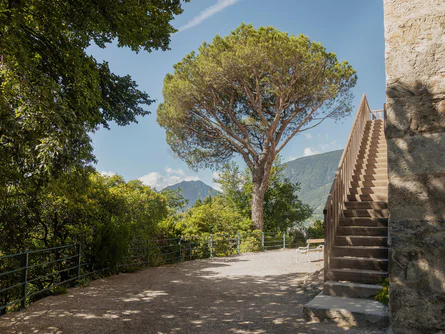The rectangular keep was once part of the imposing Ortenstein Castle, which loomed high above the town. Originally built as the residence of the Tyrolean burgrave, the castle underwent numerous alterations over the centuries and was eventually dismantled in the 16th century—except for the Gunpowder Tower. From 1626, the tower was used as a gunpowder storage to protect the city of Merano from a potentially catastrophic explosion during the Thirty Years' War. This is how it earned its name and became an important part of the town’s defensive structures.
With its two interconnected towers, the Gunpowder Tower was particularly well protected from attacks. To the north, remnants of defensive moats can still be seen, which once served as the last line of defence against invading forces.
Today, the Gunpowder Tower offers a fantastic panoramic view of Merano and the Adige Valley. The steep climb is well worth the effort: from here, you can enjoy a breathtaking view of the town and the surrounding nature. The tower is not just a piece of history, but also a wonderful viewpoint that brings the city's past and its defences to life.
Whether you’re a history enthusiast or simply looking to take in the view, the Gunpowder Tower is a must-visit during your time in Merano.
The Gunpowder Tower is located on the Tappeiner Promenade, which is basically accessible and therefore well suited for wheelchairs and pushchairs, although it is paved with gravel. The best access point for families with pushchairs or wheelchair users is from Quarazze, as the entrance is level. From there, the Gunpowder Tower is about a 1-hour walk. Alternatively, you can also start from the via Galilei street or the Gilf Promenade, although these two paths have a difference in altitude of around 60 metres. Thorough planning is therefore advisable. This tour is also suitable for older people and families with children. There are various benches along the way where you can take a break.
The Gunpowder Tower is accessible only via stairs, making it unsuitable for those with limited mobility.
Please note: There are no public toilets along the Tappeiner Promenade. However, you can stop off at the various restaurants and cafés. Please enquire in advance about their opening hours.
There is no tactile guidance system or other aids for the blind on the promenades in Merano and at the Gunpowder Tower.































































